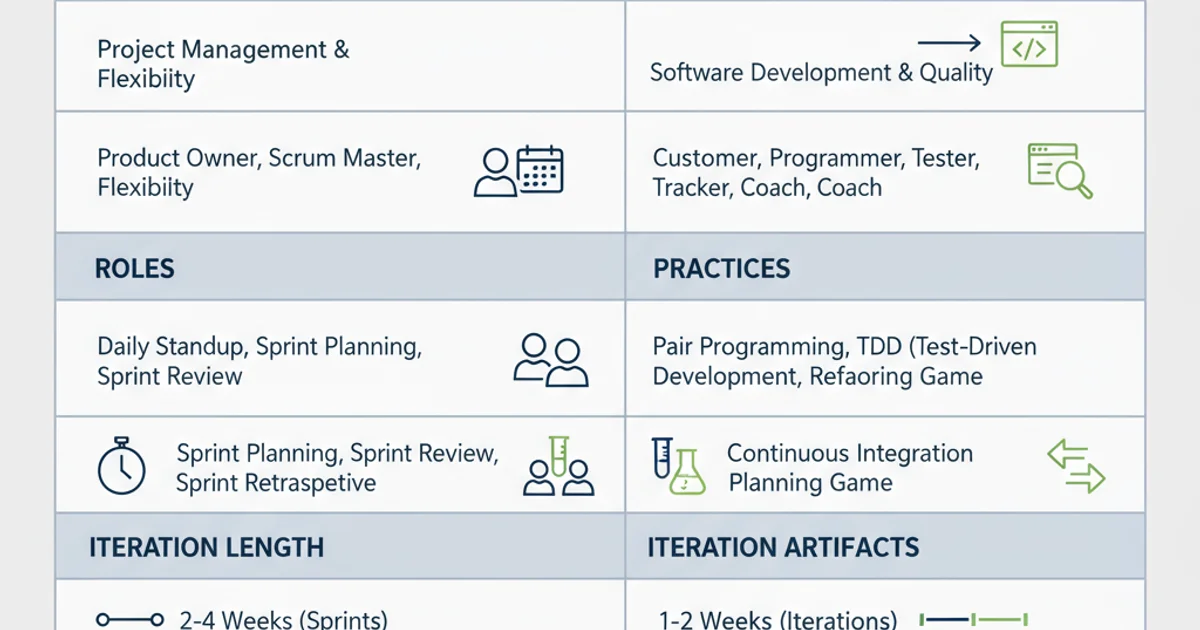What is the difference between Scrum and Extreme Programming?
Categories:
Scrum vs. Extreme Programming: Understanding Agile Methodologies

Explore the key differences and similarities between Scrum and Extreme Programming (XP), two popular agile frameworks, to help you choose the best approach for your software development projects.
Scrum and Extreme Programming (XP) are two of the most widely adopted agile methodologies in software development. While both aim to deliver high-quality software efficiently and adapt to changing requirements, they approach these goals with distinct philosophies, practices, and focuses. Understanding their core differences and commonalities is crucial for teams looking to implement an agile framework effectively.
Scrum: The Framework for Complex Product Development
Scrum is a lightweight, iterative, and incremental framework for managing complex product development. It emphasizes empirical process control, self-organizing teams, and cross-functional collaboration. Scrum defines specific roles, events, and artifacts, but it doesn't prescribe engineering practices, leaving teams to decide how they will build the product. Its strength lies in its ability to manage uncertainty and adapt to evolving requirements through short, time-boxed iterations called Sprints.
flowchart TD
A[Product Backlog] --> B{Sprint Planning}
B --> C[Sprint Backlog]
C --> D[Daily Scrum]
D -- "24 hours" --> D
C --> E[Development Work]
E --> F[Potentially Shippable Increment]
F --> G{Sprint Review}
G --> H{Sprint Retrospective}
H --> AThe Scrum Workflow: A cyclical process of planning, execution, review, and adaptation.
Extreme Programming (XP): Engineering Excellence and Customer Collaboration
Extreme Programming (XP) is a more prescriptive agile methodology that focuses heavily on engineering practices and technical excellence. It aims to improve software quality and responsiveness to changing customer requirements. XP emphasizes frequent releases in short development cycles, which is intended to improve productivity and introduce checkpoints where new customer requirements can be adopted. Its core values include simplicity, communication, feedback, respect, and courage, which are supported by a set of specific practices like pair programming, test-driven development (TDD), continuous integration, and refactoring.
graph TD
A[XP Values] --> B(Simplicity)
A --> C(Communication)
A --> D(Feedback)
A --> E(Respect)
A --> F(Courage)
B --> G[Core Practices]
C --> G
D --> G
E --> G
F --> G
G --> H(Pair Programming)
G --> I(Test-Driven Development)
G --> J(Continuous Integration)
G --> K(Refactoring)
G --> L(Small Releases)
G --> M(On-site Customer)
G --> N(Collective Code Ownership)
G --> O(Coding Standards)XP Values and their supporting Core Practices.
Key Differences and Similarities
While both Scrum and XP are agile, their emphasis and approach differ significantly. Scrum provides a project management framework, while XP offers a set of engineering practices. Many teams find success by combining elements of both, using Scrum for project management and incorporating XP's technical practices to enhance code quality and maintainability.

Comparative overview of Scrum and Extreme Programming.
When to Choose Which Methodology
Choosing between Scrum and XP, or deciding to combine them, depends on your team's specific context, project requirements, and organizational culture.
Choose Scrum if: You need a flexible framework for managing complex projects with evolving requirements. Your team values self-organization and needs a clear structure for iterative delivery. You have a Product Owner who can effectively manage the Product Backlog.
Choose XP if: Your project demands extremely high code quality and maintainability. Your team is comfortable with strict engineering practices like pair programming and TDD. You have direct and continuous access to a customer representative.
Combine Scrum and XP if: You want the project management benefits of Scrum (roles, events, artifacts) coupled with the robust engineering practices of XP to ensure high-quality, maintainable code.